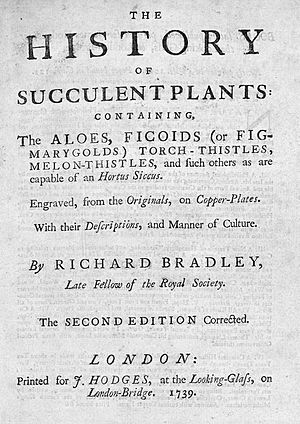Richard Bradley (botanist) facts for kids
Quick facts for kids
Richard Bradley
|
|
|---|---|
| Born | 1688 England
|
| Died | 5 November 1732 (aged 43–44) Cambridge, England
|
| Scientific career | |
| Fields | Botany |
| Institutions | University of Cambridge |
Richard Bradley (1688 – 5 November 1732) was an English naturalist who studied botany. He wrote important books about plants, gardening, and the natural world. He was also a Fellow of the Royal Society, a group of important scientists.
Richard Bradley's Early Life and Work
We don't know much about Richard Bradley's childhood. We do know he loved gardening from a young age. He lived near London, a city where many people were interested in nature.
Even though Bradley didn't go to university, his first book helped him meet important people. This book was called Treatise of Succulent Plants. With their help, he became a member of the Royal Society in 1712. He was only 24 years old.
In 1714, Bradley visited the Netherlands. There, he became very interested in horticulture, which is the art of growing plants. For the next ten years, he wrote many books in England. These books covered topics like weather, plant food, and how plants grow. He also studied how different plants can mix to create new types.
Becoming a Professor
In 1724, the University of Cambridge made Bradley their first ever professor of botany. They recognized his great work with plants. He held this job until he passed away.
Being a professor was an important title, but it didn't pay him money. So, Bradley kept writing and publishing books to earn a living. He was very dedicated to sharing his knowledge through his writings.
Amazing Discoveries and Ideas
Richard Bradley made many new discoveries and inventions. His book New Improvements of Planting and Gardening even showed how to make a simple kaleidoscope. This tool helped people design beautiful gardens.
He also loved cooking! Bradley was the first person in England to publish recipes using the pineapple. At that time, pineapples were very new and exciting.
His book History of Succulent plants was a very important work about these special plants. He also studied tulips and auriculas. His work helped scientists better understand how plants reproduce.
Bradley was also a pioneer in studying tiny fungal spores. He looked at how they grow. He also studied how insects help plants make seeds. His books also taught people how to build and use greenhouses. He even had early ideas about how to make farms produce more food. He also wrote about how ponds work.
One of Richard Bradley's most important contributions was his work on infectious diseases. Many scientists at the time had different ideas. But Bradley used careful studies and experiments. He showed that diseases could spread among plants, animals, and even humans. This was an early step towards understanding how germs cause sickness.


